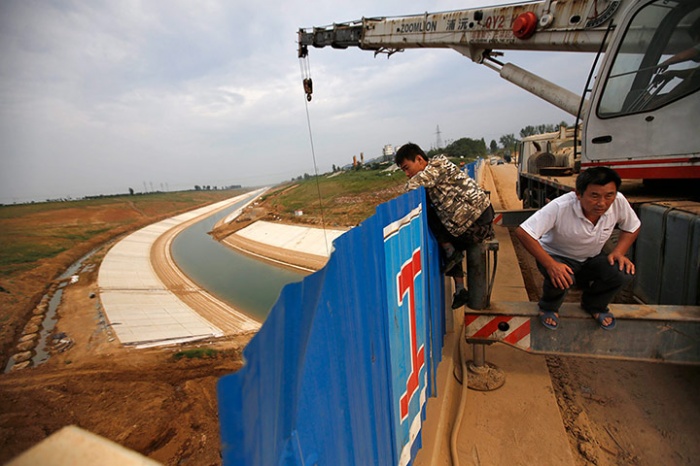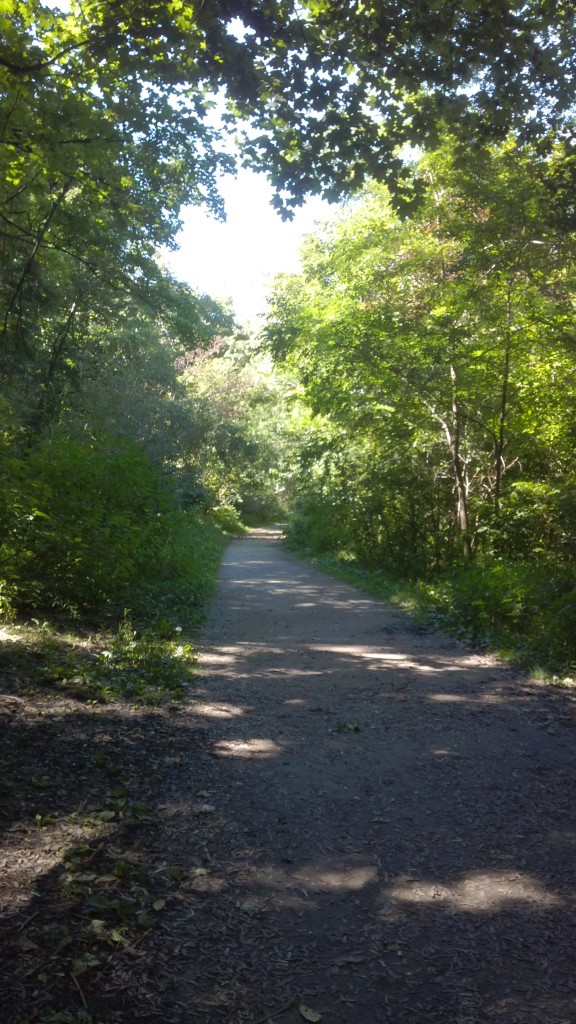October 14, 2014 – Yesterday was Thanksgiving Day in Canada and a wonderful day to walk through the wetlands south of our apartment here in the heart of Toronto. These wetlands are an attempt to restore the natural balance lost when human re-engineering of a branch of the Don River eventually caused a section of the river to disappear into concrete culverts. What was lost was the natural habitat for all kinds of wildlife. When I walked with my dog Maya along the trail yesterday (see picture below) it was exciting to see rabbits running along the path, butterflies still flitting among the fall flowers, and a wide variety of birds, many of them year-round inhabitants, but others foraging and resting before heading further south in their annual migration. I could count a half-dozen or more bird species including finches, sparrows, robins, tanagers, vireos, red-tailed hawks, blue jays, cardinals, woodpeckers, flickers….it was truly a small Eden of nature in the heart of my city.
So kudos to those who recognized the human engineered mistake of the past and have attempted to redress it here in Toronto. That cannot be said for what is happening in China’s water diversion efforts to transfer water from the Yangtze to the Huang He (Yellow) in northern China. I have written about the rivers of China in my study of how climate change is impacting Asia. At the time I mentioned the diversion project in its planning phase. But now the first stages are completed and the diversion is happening.
Both the Yangtze and Hwang He are critical freshwater resources for the hundreds of millions of humans, livestock and natural wildlife that live in close proximity to their banks. The project, known as the South-to-North Water Transfer, was first proposed by Mao Zedong upon the founding of the People’s Republic back in 1949. Hypothetically the plan would divert water from the Yangtze through pipes and canals to the Han, a Huang He tributary. The current project phase that is about to start will divert 9.5 billion cubic meters (335 billion cubic feet) of water annually. Once fully implemented the volume will increase by almost 500%. The drier north will get the water it desperately needs. But for the central parts of China there are unintended consequences which include:
- Exacerbation of an existing problem of growing freshwater shortages and low water levels along the Yangtze in Central China. The current conditions are attributed to the building of The Three Gorges Dam on the Yangtze, China’s other major environmental re-engineering experiment.
- Threatening farmland currently dependent on irrigation networks that because of low water levels will become unusable.
- Relocation of towns and villages because of falling water levels and lack of adequate freshwater resources along a 1,300 kilometer (800 plus miles) stretch.
- Loss of Yangtze flow volume resulting in increased water pollution for cities along the lower course of the river.
- Incursions of seawater into Shanghai’s water supply resulting from lower Yangtze flow volume.
- Decline in barge traffic, a principle means of transportation for much of central China, because of lower water levels.
The Three Gorges Dam is already inflicting this type of damage to the Yangtze River valley. The water diversion which has involved the building of the Danjankou Dam, will only make things worse. And for the Huang He, water diversion may introduce another unintended consequence, invasive species from the Yangtze impacting the existing biodiversity of the northern river.
China’s northern cities, Beijing and Tianjin, have undergone explosive population growth accompanied by chronic freshwater shortages. Interestingly enough, even with this massive diversion of water from the Yangtze, those shortages will not be alleviated. What China needs to do is institute freshwater conservation for agriculture, industry and residential use. Unfortunately, the prestige associated with the engineering feat has suborned such efforts and the unintended consequences will now have to be addressed.
Here in Toronto, the Don River is by no means equivalent to the Yangtze. But you can see how we humans often have a tendency to invent, design and build without looking at the much larger picture. It is a pattern which today is creating the Anthropocene, the first geologic age named after us, a period in Earth history where our imprint is altering the physical planet.













